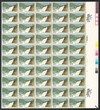
# 2042 - 1983 20c Tennessee Valley Authority
U.S. #2042
1983 20¢ Tennessee Valley Authority
- Issued on the 50th anniversary of the creation of the Tennessee Valley Authority
- Second BEP stamp printed by combo of gravure and intaglio
- Second stamp to picture the Norris hydroelectric dam
Stamp Category: Commemorative
Value: 20¢, first-class rate
First Day of Issue: May 18, 1983
First Day City: Knoxville, Tennessee
Quantity Issued: 114,250,000
Printed by: Bureau of Engraving and Printing
Printing Method: Photogravure and engraved
Format: Panes of 50 in sheets of 230
Perforations: 11
Why the stamp was issued: To commemorate the 50th anniversary of the Tennessee Valley Authority (TVA).
About the stamp design: Howard Koslow created the acrylic image for this stamp based on photos of the Norris hydroelectric facility. That dam had also previously been featured on a 1961 stamp (#1184) honoring the dam’s namesake Senator George Norris, who had played a role in establishing the TVA.
About the printing process: This was the Bureau of Engraving and Printing’s second stamp produced by a combination of gravure and intaglio printing. The first stamp (#2017) honoring the Touro Synagogue had been simpler. The gravure was printed on one side of the stamp and the intaglio on the other. On this TVA stamp, all the black lettering on the bottom left of the design was printed by intaglio, so registration of the two printing processes was more critical.
First Day City: The First Day ceremony for this stamp was held at the TVA headquarters in Knoxville Tennessee.
History the stamp represents: On May 18, 1933, President Franklin Roosevelt created the Tennessee Valley Authority to provide hydroelectric power to rural areas of six states.
Before the creation of the Tennessee Valley Authority, the citizens living in this area, which includes the states of Virginia, North Carolina, Georgia, Alabama, Kentucky, and Tennessee, lived in economic depression. Only three out of a hundred families had electricity. Most of the people received public assistance – there was very little industrial employment. Also, the Tennessee River was navigable by boats with a draft of only three feet or less.
The idea of a government-run dam wasn’t a new one. In 1918, after the U.S. entered World War I, President Woodrow Wilson approved the building of a dam and two nitrate plants for the war effort (nitrate was needed for ammunition and explosives) in Muscle Shoals, Alabama.
Within months the dam employed over 18,000 people, but the war ended before the dam was completed. People then questioned whether the Wilson Dam should remain in government hands, or be sold to a private company.
The dam’s fate hung in the balance for three years, until Henry Ford and Thomas Edison visited in 1921. Ford believed he could transform the area into a thriving metropolis. Word quickly spread of his plans and people from all over the country began buying plots of land without even looking at them first. Ford then offered Congress $5 million for the dam. However, Nebraska Senator George Norris was staunchly opposed to the idea of a privately owned company running the dam. He believed that the public should benefit from the government investment there, not a private company. Congress ultimately agreed and turned down Ford’s offer, though his plan helped lay the groundwork for the area’s eventual development.
Norris then sponsored the Muscle Shoals Bill, proposing the building of a government-run dam in the Tennessee River that would provide electricity to the rural population. Though it passed both houses of Congress, President Calvin Coolidge and Herbert Hoover vetoed the bills, believing that it was a job for private companies. According to Hoover, “for the Federal Government deliberately to go out to build up and expand such an occasion to the major purpose of a power and manufacturing business is to break down the initiative and enterprise of the American people; it is the negation of the ideals upon which our civilization has been based.”
Norris didn’t give up his fight, and eventually found an ally in President Franklin Roosevelt. Roosevelt had created several innovative New Deal programs to lift America out of the Great Depression. Working with Norris, he developed the Tennessee Valley Authority (TVA). In his message to Congress, he described it as “a corporation clothed with the power of government but possessed of the flexibility and initiative of a private enterprise.” Congress supported the idea and passed the Tennessee Valley Authority Act on May 18, 1933.
According to the TVA Act, it was created “To improve the navigability and to provide for the flood control of the Tennessee River; to provide for reforestation and the proper use of marginal lands in the Tennessee Valley; to provide for the agricultural and industrial development of said valley; to provide for the national defense by the creation of a corporation for the operation of Government properties at and near Muscle Shoals in the State of Alabama, and for other purposes.”
With the creation of the TVA, the natural resources of this area were developed. The TVA was given the task of building flood-control and electric-power facilities on the Tennessee River. The TVA and a private firm, the Alabama Power Company, built several dams and hydroelectric plants in Alabama. These plants provided inexpensive power for factories in the state.
Through the years, the TVA has built many dams to control floods, create hydroelectric power, to make the river navigable, and to create lakes. New forests were planted, and soil conservation techniques were put in place. The resulting dams produce more than 32,000 megawatts of electricity, as well as jobs for the people of the region.
U.S. #2042
1983 20¢ Tennessee Valley Authority
- Issued on the 50th anniversary of the creation of the Tennessee Valley Authority
- Second BEP stamp printed by combo of gravure and intaglio
- Second stamp to picture the Norris hydroelectric dam
Stamp Category: Commemorative
Value: 20¢, first-class rate
First Day of Issue: May 18, 1983
First Day City: Knoxville, Tennessee
Quantity Issued: 114,250,000
Printed by: Bureau of Engraving and Printing
Printing Method: Photogravure and engraved
Format: Panes of 50 in sheets of 230
Perforations: 11
Why the stamp was issued: To commemorate the 50th anniversary of the Tennessee Valley Authority (TVA).
About the stamp design: Howard Koslow created the acrylic image for this stamp based on photos of the Norris hydroelectric facility. That dam had also previously been featured on a 1961 stamp (#1184) honoring the dam’s namesake Senator George Norris, who had played a role in establishing the TVA.
About the printing process: This was the Bureau of Engraving and Printing’s second stamp produced by a combination of gravure and intaglio printing. The first stamp (#2017) honoring the Touro Synagogue had been simpler. The gravure was printed on one side of the stamp and the intaglio on the other. On this TVA stamp, all the black lettering on the bottom left of the design was printed by intaglio, so registration of the two printing processes was more critical.
First Day City: The First Day ceremony for this stamp was held at the TVA headquarters in Knoxville Tennessee.
History the stamp represents: On May 18, 1933, President Franklin Roosevelt created the Tennessee Valley Authority to provide hydroelectric power to rural areas of six states.
Before the creation of the Tennessee Valley Authority, the citizens living in this area, which includes the states of Virginia, North Carolina, Georgia, Alabama, Kentucky, and Tennessee, lived in economic depression. Only three out of a hundred families had electricity. Most of the people received public assistance – there was very little industrial employment. Also, the Tennessee River was navigable by boats with a draft of only three feet or less.
The idea of a government-run dam wasn’t a new one. In 1918, after the U.S. entered World War I, President Woodrow Wilson approved the building of a dam and two nitrate plants for the war effort (nitrate was needed for ammunition and explosives) in Muscle Shoals, Alabama.
Within months the dam employed over 18,000 people, but the war ended before the dam was completed. People then questioned whether the Wilson Dam should remain in government hands, or be sold to a private company.
The dam’s fate hung in the balance for three years, until Henry Ford and Thomas Edison visited in 1921. Ford believed he could transform the area into a thriving metropolis. Word quickly spread of his plans and people from all over the country began buying plots of land without even looking at them first. Ford then offered Congress $5 million for the dam. However, Nebraska Senator George Norris was staunchly opposed to the idea of a privately owned company running the dam. He believed that the public should benefit from the government investment there, not a private company. Congress ultimately agreed and turned down Ford’s offer, though his plan helped lay the groundwork for the area’s eventual development.
Norris then sponsored the Muscle Shoals Bill, proposing the building of a government-run dam in the Tennessee River that would provide electricity to the rural population. Though it passed both houses of Congress, President Calvin Coolidge and Herbert Hoover vetoed the bills, believing that it was a job for private companies. According to Hoover, “for the Federal Government deliberately to go out to build up and expand such an occasion to the major purpose of a power and manufacturing business is to break down the initiative and enterprise of the American people; it is the negation of the ideals upon which our civilization has been based.”
Norris didn’t give up his fight, and eventually found an ally in President Franklin Roosevelt. Roosevelt had created several innovative New Deal programs to lift America out of the Great Depression. Working with Norris, he developed the Tennessee Valley Authority (TVA). In his message to Congress, he described it as “a corporation clothed with the power of government but possessed of the flexibility and initiative of a private enterprise.” Congress supported the idea and passed the Tennessee Valley Authority Act on May 18, 1933.
According to the TVA Act, it was created “To improve the navigability and to provide for the flood control of the Tennessee River; to provide for reforestation and the proper use of marginal lands in the Tennessee Valley; to provide for the agricultural and industrial development of said valley; to provide for the national defense by the creation of a corporation for the operation of Government properties at and near Muscle Shoals in the State of Alabama, and for other purposes.”
With the creation of the TVA, the natural resources of this area were developed. The TVA was given the task of building flood-control and electric-power facilities on the Tennessee River. The TVA and a private firm, the Alabama Power Company, built several dams and hydroelectric plants in Alabama. These plants provided inexpensive power for factories in the state.
Through the years, the TVA has built many dams to control floods, create hydroelectric power, to make the river navigable, and to create lakes. New forests were planted, and soil conservation techniques were put in place. The resulting dams produce more than 32,000 megawatts of electricity, as well as jobs for the people of the region.









